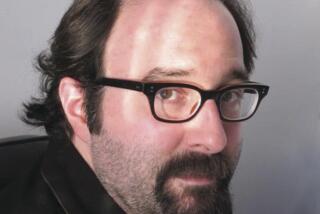Movies that really leapt off the screen
- Share via
When movies seemed in danger of losing audiences to TV in the early 1950s, Hollywood tried to find ways to lure to people back into theaters. (Remember wide-screen movies?) One gimmick that worked for a while was 3-D films. Their golden age began in 1952 with the action flick “Bwana Devil.” Over the next few years, 50 3-D movies were made before the novelty wore off.
In the ‘80s, 3-D returned with such forgettable entries as “Jaws 3-D” and “Amityville 3-D.” More recently, audiences have been donning the special glasses again, the next time for a new adaptation of Jules Verne’s “Journey to the Center of the Earth,” opening today.
Among the old clinkers are some worthy 3-D films. Jeff Joseph, president of the 3-D Film Preservation Fund and producer of World 3-D Film Expos I and II at the Egyptian Theatre, picks these five greatest films from the golden age.
“House of Wax” (1953)
Vincent Price, Frank Lovejoy, Phyllis Kirk, Carolyn Jones and a young Charles Bronson star in this classic thriller about a deranged wax figure sculptor (Price) who uses real bodies for his chamber of horrors wax museum. Ironically, director Andre De Toth was blind in one eye and couldn’t experience the 3-D effects.
“It’s not only really well made,” Joseph says, “but the 3-D is terrific, and it’s a good story. It’s not cheaply done in any sense. It’s very much a studio [Warner Bros.] film with a good budget. Every time it got rereleased and when we have run it at the expos, it draws a huge crowd.
“There were 50 movies done in English in 3-D during the golden age, and maybe 15 or 16 were originally shown in stereophonic sound. Of those, only two [soundtracks] have survived. The others were lost. The worst one that is lost is ‘House of Wax’ because not only is it a terrific score -- they made a big deal of it being in stereo -- it was more or less the first time people heard stereophonic anything. It played all over the country in stereo. But they are just lost tracks. It’s very sad.”
“Kiss Me Kate” (1953)
George Sidney directed this rollicking version of the Cole Porter Broadway hit about divorced theater stars (Kathryn Grayson and Howard Keel) playing Katherine and Petruccio in a Broadway-bound musical adaptation of “The Taming of the Shrew.”
Though most reference books state that “Kiss Me Kate” had a limited 3-D release, that isn’t true, even though “it did not show in 3-D at Radio City Music Hall. It showed flat there,” Joseph says.
“But actually, it had the largest 3-D print run that Technicolor did up to that time. It was a huge print release -- 250 -- that’s a lot.”
“Dial M for Murder” (1954)
Alfred Hitchcock directed this thriller based on the Frederick Knott play set in the London flat of a former tennis player (Ray Milland), married to a beautiful young woman (Grace Kelly) mainly for her money. After learning of her affair with a crime writer (Robert Cummings), Milland’s Tony plans his wife’s murder. “Dial M” is best known for the scene of Kelly grabbing a pair of scissors to defend herself.
“The 3-D is so subtle in most of the film that when it really gets out there with the scissors scene, the audience really reacts to it,” Joseph says. “That’s why it works so well. It’s a terrific scene. That movie plays a lot better in 3-D than it does flat. It’s a very stagy movie. But when you watch it in 3-D, you feel like there is some depth to it.”
Because the 3-D format was dying out by the time “Dial M” was set to open, Warner Bros. ended up releasing it in the flat, 2-D version. In fact, when the old Tiffany revival theater in West Hollywood showed the 3-D version a few decades ago, the theater’s owner, Tom Cooper, advertised that it was the first time “Dial M” had been shown in public in 3-D.
“We all thought that was true,” Joseph says. “We knew that Warners sent it out in 1954 in 3-D, but it didn’t play that way. I have ads from the Wednesday it opened saying in ‘3-D,’ and the next day, the ads don’t say 3-D. Literally, the Tuesday [before it opened] Warners decided not to release it in 3-D. However, we recently found a small theater in the middle of nowhere Tennessee that ran ‘Dial M’ in 3-D for three days in 1954.”
“Creature From the Black Lagoon” (1954)
One of the great Universal monster movies, “Creature From the Black Lagoon” is about a geology expedition to the Amazon that uncovers a prehistoric Gill Man, who falls for the girlfriend (Julie Adams) of one of the scientists (Richard Carlson).
“It’s one of the most iconic films of the period,” Joseph says. “It holds up really well. There’s underwater 3-D cinematography. The film was so successful that, in 1955, Universal did ‘Revenge of the Creature’ in 3-D even though 3-D had died by then.”
“It Came From Outer Space” (1953)
Jack Arnold directed this Universal sci-fi flick -- its poster proclaimed: “Fantastic Sights Leap at You! In 3-Dimension. Amazing! Exciting! Spectacular!” -- about an alien spacecraft that crash-lands in the Arizona desert.
“Not only is it terrific 3-D,” Joseph says, “it also had a wonderful stereophonic soundtrack, which we restored. It’s very early stereo, and it’s very clean and wonderful stereophonic sound.”
--
More to Read
Only good movies
Get the Indie Focus newsletter, Mark Olsen's weekly guide to the world of cinema.
You may occasionally receive promotional content from the Los Angeles Times.











